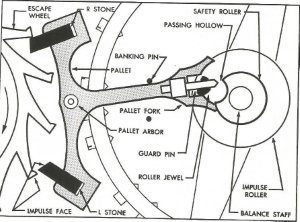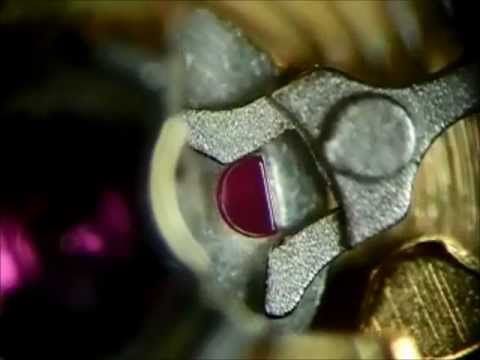Amplitude is the measure of the amount of rotation in the swing of the balance wheel, in either direction, expressed in degrees,typically in the range of about 270 to 315 degrees.
When amplitude is too high, you get knocking or rebanking.
An amplitude of 270 means that a point on the balance wheel is turning 3/4 of a full circle. As amplitude hits 360, the wheel is making a full rotation, and you’ll likely get knocking.
How it Sounds
The balance wheel can only rotate so much. At a point, the balance travels so far that the roller jewel bangs against the other side of the pallet fork. This banging sound is usually audible. Instead of ticking and tocking, the watch sounds like a galloping horse.
When a watch is rebanking, it will run extremely fast and will be unusable. As the wheel bounces from one end of the pallet to the other, it picks up speed and will run hours too fast.
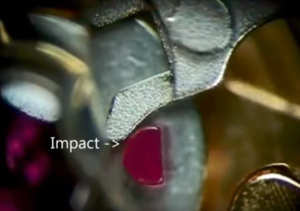
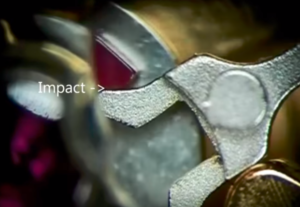
Testing for Rebanking
When knocking is severe, however, you might see only “timing noise” – the dreaded cloud of dots on the timing machine.
So, to properly diagnose knocking, we need to complete a second step. Many things can cause noisy timing traces, and we need to rule several of them out.
Let down the power from the mainspring, wind the watch to around 20%, and then observe the timing machine.
Because the power from the mainspring is much lower, amplitude will also be lower. So, if knocking is the problem, the lines should be clean and stable when the watch runs at low wind.
Watches will normally stop rebanking when in stem positions, as the balance wheel is now riding on both top and bottom pivots, and this slight increase in friction normally stops the rebanking.
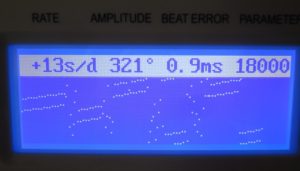
How common is it?
On the friction side, modern cleaning solutions can get jewels and pinions surgically clean. Modern lubricants—especially oils for pallet jewels, will do wonders for amplitude.
Modern white alloy mainsprings are very powerful. Vintage watches from the earlier half of the 1900s were designed with blued steel mainsprings in mind.
These would “set” (lose their elasticity and form into a spiral shape) quickly and break often. White alloy mainsprings, in contrast, don’t become “set,” and they deliver force more consistently.
A mainspring’s strength is expressed in its thickness. In the old days, repairers could choose from a range of mainspring strengths. The modern watchmaker, however, usually has only 1 option, which may be the strongest one.
Taken together, the stronger mainsprings, cleaner watches, and better lubricants can crank up the amplitude.
Solving the Problem
There is really no good solution to this problem, other than trying various mainsprings. Unfortunately most watches have one spring that should be used and trying lots of different sizes is not cost effective.
Here are few options to try and solve this problem.
- remove and clean the pallet, and then under oil it
- use heavier oil for the escape wheel or balance wheel
- lubricate the pallet arbor jewels
- Remove some of the end shake on the balance bridge
- No lubrication in the mainspring barrel
Parts and Names Associated with a Watch Escapement
